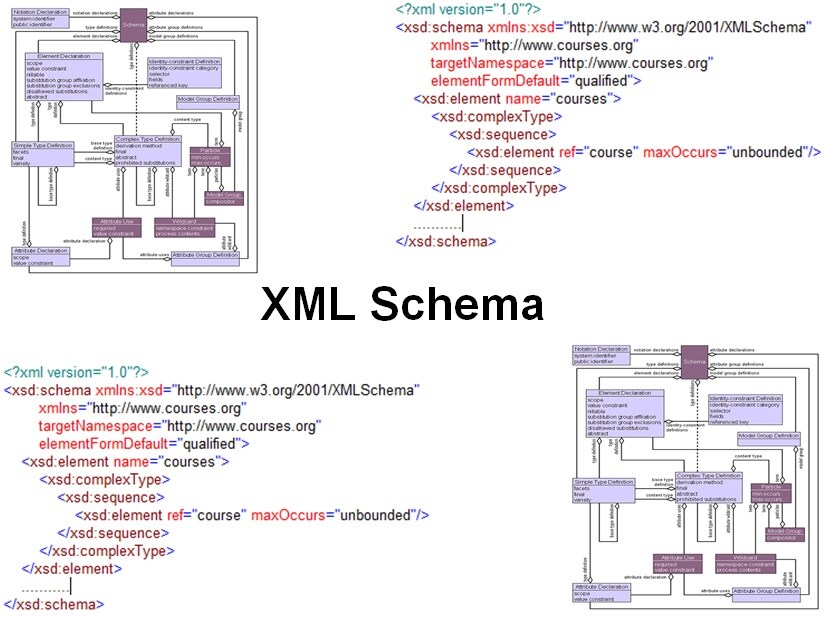-
Learning by doing
-
Trainers with practical experience
-
Classroom training
-
Detailed course material
-
Clear content description
-
Tailormade content possible
-
Training that proceeds
-
Small groups
In the course XML Schema you will gain extensive knowledge on the syntax and usage of the XML Schema language, as successor to Document Type Definitions (DTDs).
XML Schema is used to define XML vocabulaires that define the structure, element names and contents of XML documents.
Several XML Schema design models are discussed like Russian Doll, Salami Slice and Venetian Blind. Attention is given to declaring simple and complex elements and types and imposing constraints on the content of elements.
Also the creation of user defined simple data types using facets and regular expressions is among the subjects discussed. Namespaces are an important part in the XML Schema specification and is given a lot of attention.
Also the creation of complex derived data types and the difference between derivation by restriction and derivation by extension are discussed.
Further attention is paid to modularization of schemas and the usage of the include and import mechanisms.
Finally some advanced topics like Open Content Models and the XML Schema handling of keys and references and the removing of redundancy by identity constraints are addressed.
The course XML Schema is designed for developers of XML data structures and XML applications and project managers who want to use XML schemas to validate the contents of XML documents.
To join this course knowledge of the basic syntax of XML is required.
The theory is discussed on the basis of presentation slides. Demos are used to illustrate the theory. There is ample opportunity to practice. The course material is in English. The course time are from 9.30 up and to 16.30.
Participants receive an official certificate XML Schema after successful completion of the course.

Module 1 : XML-Schema Intro |
Module 2 : XML Schema Basics |
Module 3 : XML Schema Models |
| Why XML Schema? What is XML Schema? Markup Languages Well Formed versus Valid Document Type Definition (DTD) DTD Limitations XML Schema as DTD Successor XML Schema Features Typical Use of XML Schema Use of XML Schema Other Uses of XML Schema Schema Validators |
XML Schema Components DTD to XML Schema Conversion DTD Vocabulary XML Schema Vocabulary Target Vocabulary Referencing XML Schema XMLSchema-instance Multiple Levels of Checking Element Cardinality Simple and Complex Types Simple Type Restricted to Integer Complex Type with Attribute |
Declaration versus Definition Global versus Local Element Declarations Global and Local Declarations Referencing Global Declarations Anonymous and Named Types Three Design Approaches Salami Slice Design Russian Doll Design Venetian Blind Design Combined Design Design Comparisons |
Module 4 : XML Schema Data Types |
Module 5 : Derived Simple Types |
Module 6 : Schema Documentation |
|
XML Schema Data Types String Data Types Language Data Type Name Types ID Types Qualified Names and URI's Binary String Encoded Types Primitive Numeric Data Types Derived Numeric Data Types Boolean Data Type Date Data Types ur-type and anyType |
Creating Simple Types Derived Numeric Simple Types Simple Types by Restriction Available Facets Enumerations and Patterns Fixing Facet Values Regular Expressions Meta Characters Quantifiers Character Classes List Type and simpleTypes Union type and simpleTypes |
Annotating Schema's Annotation Element Meta Data Allowed Locations Annotation Location Inlining Annotation Documentation Element Appinfo Element Optional Attributes source Attribute xml:lang Attribute Defining Semantics |
Module 7 : Namespaces |
Module 8 : Complex Types |
Module 9 : Derived Complex Types |
|
Namespaces of XML Schema XML Schema Namespace TargetNamespace Referencing XML Schema Namespace Scope Default Namespace Symbol Spaces Name Conflicts What is in the Namespace? Namespace Qualification elementFormDefault attributeFormDefault Rules for using Namespaces |
Simple Content and Attributes Local Attribute Declarations use Attribute Grouping Attributes Grouping Elements Global Group Definition Choice Element Fixed Element Values Default Element Values Sequence and Choice Any order with all Empty element nil and Mixed content |
Derived Complex Types Deriving by Extension Deriving by Restriction Prohibiting Derivations Element Substitution Substitutable Elements International Clients substitutionGroup Features Substitution with Derived Types Blocking Element Substitution Transitive and Non-Symmetric Abstract Elements Abstract complexType |
Module 10 : Schema Modules |
Module 11 : Schema Extensions |
Module 12 : Uniqueness and Keys |
| Schema Modularization Including Schema Documents Using include Chameleon Effect Namespace Coercion Redefining Types Using redefine Redefine no targetNamespace Importing Schema Documents Using import |
any Element Extension Element Instance with any Namespace Extension Elements anyAttribute Element Extension Attribute Instance with anyAttribute Namespace Extension Attributes Open Content Global and Local Openness |
Uniqueness and Keys Unique versus Key Key Requirements Combination Key Unique Unique Elements Key Referencing IDREF key Element keyref Element |
